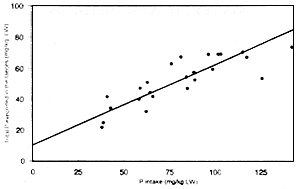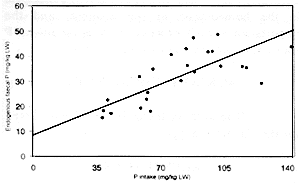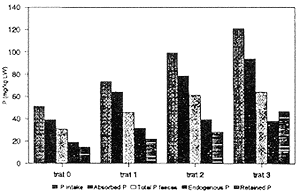Abstracts
The main objective of the present work was to determine the effects of different dietary phosphorus (P) levels on endogenous faecal loss and to estimate the minimum daily requirement of P for sheep. The study was conducted with 24 Suffolk sheep which received a basic diet consisting of hay-concentrate mixture. The treatments consisted of different amounts of bone meal, added to the basic diet, so as to obtain supplementary P levels of 0, 1, 2 and 3g/day. Twenty-one days after the introduction of the experimental diet, 7.4 MBq radioactive P (32P) was injected into the left jugular vein of each sheep and blood, faeces and urine samples were collected daily for 8 days at 24-hour intervals. The samples were analysed for inorganic P and for radioactive specific activities. Mean endogenous faecal losses of P were 19.00, 31.79, 39.35, and 38.06mg/kg live weight (LW) per day in sheep supplemented with 0, 1, 2, and 3g, respectively. A positive linear relationship was observed between endogenous faecal loss and consumed P, indicating that this loss was linked to dietary P. Total P excretion in the faeces, as well as P absorption, retention, urinary excretion and salivary secretion were also directly related to P intake, as part of the mechanism of homeostatic control of organism animal. The minimum endogenous faecal loss for zero P intake, calculated by interpolation, was 8.27mg/kg LW per day, and for zero balance, the calculated phosphorus consumption was 21.36mg/kg LW per day.
phosphorus; sheep; nutrition
O objetivo do presente trabalho foi determinar o efeito de diferentes níveis de fósforo (P) da dieta na perda endógena fecal e estimar a necessidade mínima diária daquele elemento para ovinos. Foram utilizados 24 ovinos da raça Suffolk que receberam uma dieta básica de feno e mistura concentrada. Os tratamentos constituíram-se de diferentes quantidades de farinha de osso adicionada à dieta básica com a finalidade de se obter níveis de P suplementar de 0, 1, 2 e 3g/dia. Vinte e um dias após início da dieta experimental, foram injetados pela veia jugular esquerda 7,4 MBq de P radioativo (32P) em cada ovino e amostras de sangue, fezes e urina foram colhidas durante 8 dias com um intervalo de 24 horas entre as colheitas. Foram determinados o teor do P inorgânico e as atividades radioativas específicas. Os valores médios de perda endógena fecal nos tratamentos 0, 1, 2 e 3g, foram 19,00; 31, 79; 39,35; 38,06mg/kg de peso vivo (PV) por dia , respectivamente. Houve uma relação linear positiva entre perda endógena fecal e P consumido, indicando que esta perda está vinculada ao P da dieta. A excreção total nas fezes, absorção, retenção, excreção urinária e secreção salivar de P foram também relacionadas diretamente com o P consumido, fazendo parte do mecanismo de controle homeostático do organismo animal. A perda endógena fecal mínima para o consumo zero de fósforo foi de 8,27mg/kg PV por dia, e para balanço zero o fósforo consumido calculado foi de 21,36mg/kg PV por dia.
fósforo; ovinos; nutrição
PHOSPHORUS METABOLISM AND ESTIMATION OF PHOSPHORUS REQUIREMENTS FOR SHEEP1 1 Parte da tese de doutoramento do primeiro autor, CENA/USP.
H. LOUVANDINI; D.M.S.S. VITTI
Centro de Energia Nuclear na Agricultura/USP, C.P. 96, CEP: 13400-970, Piracicaba, SP.
ABSTRACT: The main objective of the present work was to determine the effects of different dietary phosphorus (P) levels on endogenous faecal loss and to estimate the minimum daily requirement of P for sheep. The study was conducted with 24 Suffolk sheep which received a basic diet consisting of hay-concentrate mixture. The treatments consisted of different amounts of bone meal, added to the basic diet, so as to obtain supplementary P levels of 0, 1, 2 and 3g/day. Twenty-one days after the introduction of the experimental diet, 7.4 MBq radioactive P (32P) was injected into the left jugular vein of each sheep and blood, faeces and urine samples were collected daily for 8 days at 24-hour intervals. The samples were analysed for inorganic P and for radioactive specific activities. Mean endogenous faecal losses of P were 19.00, 31.79, 39.35, and 38.06mg/kg live weight (LW) per day in sheep supplemented with 0, 1, 2, and 3g, respectively. A positive linear relationship was observed between endogenous faecal loss and consumed P, indicating that this loss was linked to dietary P. Total P excretion in the faeces, as well as P absorption, retention, urinary excretion and salivary secretion were also directly related to P intake, as part of the mechanism of homeostatic control of organism animal. The minimum endogenous faecal loss for zero P intake, calculated by interpolation, was 8.27mg/kg LW per day, and for zero balance, the calculated phosphorus consumption was 21.36mg/kg LW per day.
Key words: phosphorus, sheep, nutrition
METABOLISMO DO FÓSFORO E ESTIMATIVA DO SEU REQUERIMENTO EM OVINOS
RESUMO: O objetivo do presente trabalho foi determinar o efeito de diferentes níveis de fósforo (P) da dieta na perda endógena fecal e estimar a necessidade mínima diária daquele elemento para ovinos. Foram utilizados 24 ovinos da raça Suffolk que receberam uma dieta básica de feno e mistura concentrada. Os tratamentos constituíram-se de diferentes quantidades de farinha de osso adicionada à dieta básica com a finalidade de se obter níveis de P suplementar de 0, 1, 2 e 3g/dia. Vinte e um dias após início da dieta experimental, foram injetados pela veia jugular esquerda 7,4 MBq de P radioativo (32P) em cada ovino e amostras de sangue, fezes e urina foram colhidas durante 8 dias com um intervalo de 24 horas entre as colheitas. Foram determinados o teor do P inorgânico e as atividades radioativas específicas. Os valores médios de perda endógena fecal nos tratamentos 0, 1, 2 e 3g, foram 19,00; 31, 79; 39,35; 38,06mg/kg de peso vivo (PV) por dia , respectivamente. Houve uma relação linear positiva entre perda endógena fecal e P consumido, indicando que esta perda está vinculada ao P da dieta. A excreção total nas fezes, absorção, retenção, excreção urinária e secreção salivar de P foram também relacionadas diretamente com o P consumido, fazendo parte do mecanismo de controle homeostático do organismo animal. A perda endógena fecal mínima para o consumo zero de fósforo foi de 8,27mg/kg PV por dia, e para balanço zero o fósforo consumido calculado foi de 21,36mg/kg PV por dia.
Descritores: fósforo, ovinos, nutrição
INTRODUCTION
There is controversy about P metabolism, especially about its endogenous loss (Challa et al., 1989). According to the ARC (1980), the endogenous fraction remains constant until the animal satisfies its requirements and should be computed for the calculation of the latter. However, this statement about the constancy of endogenous P loss has been often questioned (Boxebeld et al., 1983; Braithwaite, 1984, 1985; Challa et al., 1989; Ternouth, 1989) who found that endogenous faecal loss of P was directly related to consumed P. A reevaluation by the AFRC (1991) has led to higher recommended values than those proposed by the ARC (1980). On this basis, the present study was undertaken to obtain further information about P kinetics in sheep supplemented with different dietary P levels and to calculate the minimum daily requirements of P for the animals under the experimental conditions employed.
MATERIAL AND METHODS
The study was carried out on 24 castrated male Suffolk sheep, 18 month aged, with mean live weight of 40kg, maintained in metabolic cages and receiving a basic diet consisting of 200g cassava meal, 15g urea, 10g micronutrients and Brachiaria decumbens hay ad libitum. Different amounts of bone meal (0; 8.61; 17.23 and 25.83g) were added to the diet in order to supply 0, 1, 2 and 3g of supplementary P, respectively. Total P in the diet was determined according to Sarruge & Haag (1974).
The sheep were fed with the diets for 3 weeks, and food intake and faecal and urine excretion were measured daily. On the 21st day, 7.4 MBq 32 P was injected into the left jugular vein of each animal. Blood samples were collected 5 minutes after injection and, thereafter, every 24 hours for 7 days.
After centrifugation, blood plasma was separated and analysed for inorganic P (Fiske & Subbarow, 1925) and radioactivity was determined by the Cerenkov effect.
Of the faeces collected daily, 10% was separated and digested for analysis of inorganic P and for radioactivity measurements. Inorganic P was also measured in urine by the method of Morse et al. (1992). Endogenous faecal P and real P absorption were determined on the basis of specific activity in faeces and plasma.
The experimental design was in randomized blocks, with 3 blocks and 4 treatments. Data were analysed statistically by polynomial regression and means were compared by the Tukey test.
RESULTS AND DISCUSSION
TABLE 1 indicates the parameters associated with P metabolism, and shows that the animals were in a positive balance, indicating that there was no P deficiency even for those with no bone meal offered (treatment 0 ). Thus, the levels of P intake (Pi) were adequate.
Braithwaite (1985) classified the deficiency or adequacy of consumped P in sheep as: 27.0mg/kg LW, highly deficient; 57.3mg/kg LW, marginally deficient; 96.4mg/kg LW, adequate. This classification was based on the retention values of -25.3, -7.8 and 24.2mg/kg LW, respectively.In the present experiment, the lowest level of P intake (48.14mg/kg LW) may be considered to be marginal according to the above classification but, even so, no negative retention values were observed.
Plasma P levels were normal within the 4 to 9mg/100 ml range, according to Thompson (1978). No significant differences were observed between treatments, althougth the sheep offered the zero diet exhibited the lowest P levels.
Urinary P excretion (Pu) was low in all treatments (1.0-1.5%of P intake).It has been suggested that urinary excretion of P occurs when the plasma concentration only exceeds the renal threshold for P, usually between 6.2 and 9.3 mg/100ml (Challa et al. 1989).Urinary P excretion increased with the P content of diet (Pu = 0.016Pi - 0.31; r = 0.84; P<0.018) as illustrated in Figure 1.
Total P excreted (Pt) into the faeces was related to P intake as Pt=0.52 Pi + 10.09 (r=0.95;p<0.01) (Figure 2). P present in the faeces corresponded on average to 66.6% of consumed P, in agreement with other investigators (Field et al., 1983; Vitti et al. 1992), confirming that in ruminants P is mainly eliminated through the faeces.
- Total P excreted in the faeces as a function of intake (Pt = 0.516Pi + 10.09; r=0.95; P<0.01)
Salivary P secretion (Ps) was related to Pintake (Ps = -0.077 Pi 2 + 13.67 Pi -389.18; P<0.021; r = 0.88) as shown in Figure 3.There was a correlation between P salivary and P absorption (Pa) (r=0.58, P<0.001) and P endogenous faecal loss (r=0.73, P<0.001). There was a decrease in salivary P secretion above 100mg/kg LW of P intake, suggesting saturation of the salivary secretion mechanisms at high rate of P intake.
Figure 4 illustrates the relationship between endogenous faecal loss (Pe) and P intake (Pe=0.29Pi + 8.27; P<0.001; r=0.81). A similar relationship was reported previously (Braithwaite, 1984). Endogenous faecal loss represented approximately 62% of total excreted P and a high correlation was obtained between these parameters (r = 0.76; p<0.0001).
Since the major source of endogenous P in the faeces originates from P secreted through saliva, the decrease in salivary P values also reflected on the stabilization of the endogenous loss values, starting when P intake exceeded 100mg/kg LW.
By extrapolating the curve in Figure 4 towards the zero value of consumed P, a minimum endogenous faecal loss of 8.27mg/kg LW can be obtained. This value, taken together with the P present in urine, represents the amount of P the animal lost at zero P intake. Mean endogenous urinary loss was 1mg/kg LW. Thus, it follows that the minimal total P loss would be 9.27mg/kg LW.
A highly significant positive linear relationship was obtained between P intake and P absorption (Pa) (Pa=0.77 Pi - 1.78; P<0.001; r = 0.99) as indicated in Figure 5. This increased absorption (62%-74%) with increasing amounts of consumed P (35-135mg/kg LW) has been reported previously (Braithwaite, 1984, 1985) and this increase is suggested to be due to passive P transport through the pressure exerted by the large amount of P at the absorption site. In contrast to these data, Challa et al. (1989) observed that P absorption stabilized in cattle starting from 75mg/kg LW consumed P. These investigators proposed that this was due to the occurrence of homeostatic control mechanisms leading to a decrease in the absorption coefficient or due to a progressive saturation of the P absorption mechanism.
The absorption coefficients did not differ between treatments. Absorption efficiency may be linked to the P requirements of the animals and may be responsible for the active transport of the mineral. It has been speculated that the lower the consumption, the higher the absorption coefficient should be (Braithwaite, 1984).
There was a positive relationship between P retained (Pr) and P intake (Pr=0.46Pi - 9.83, P<0.01; r=0,92) as depicted in Figure 6. By extrapolating to zero P intake, the sheep appear to be in negative P balance (-9.83mg/kg LW). This value is close to the minimum endogenous loss (9.27mg/kg LW), emphasizing that, even without ingesting P, the animal draws upon its stores to excrete this amount in an unavoidable manner.
For the animal to stay in zero P balance, i.e., with no retention, the amount of P intake, calculated by the equation Pr = 0.46 Pi - 9.83, would be 21.36mg/kg LW or 0.85g/day for 40 kg sheep. This value is closed to that estimated by the AFRC (1991) (0.80g/day). In contrast, the ARC (1980) suggests an amount of 14mg/kg LW or 0.56g/day, a value significantly lower than that obtained here. These differences are due to the fact that the available calculations are based on a factorial method involving estimates of P retention and secretion during growth, pregnancy and lactation.
Figure 7 was elaborated for a better understanding of the behavior of P in animals. The histogram shows that absorbed P increases with increasing P intake in a significant manner (P<0.01). An increase in total P excreted through the faeces occurs in response to the increase in absorbed P, up to the treatment with 2g. Since this last parameter is closely related to endogenous faecal loss, an equal effect of stabilization of this loss is observed starting from the treatment with 2g, with the consequent occurrence of the opposite effect in retention, which increases significantly for the treatments with 2 and 3g. The increase in the retained amount without a corresponding increase in serum P concentration suggests that the mineral may be present as a component of structures or in other fluids.
CONCLUSIONS
There was an unavoidable endogenous faecal P loss related to P intake. At zero P intake this loss was 8.27 mg/kg LW.
A P intake of 21.36 mg/kg LW is necessary for a 40 kg LW Suffolk sheep to reach a zero P balance, under the present experimental conditions.
Salivary excretion, urinary excretion, absorption and retention of phosphorus participate in the homeostasis of the element, and the importance of each process depends on animal P status and the amount of P in the diet.
ACKNOWLEDGEMENTS
The authors thank FAPESP and CNPq for the financial support.
Recebido para a publicação em 30.01.96
Aceito para publicação em 27.02.96
- AGRICULTURAL AND FOOD RESEARCH COUNCIL. Technical Committee on Responses to Nutrients. A Reappraisal of the calcium and phosphorus requirements of sheep and cattle. Nutrition Abstracts and Reviews. Series B: Livestock Feeds and Feeding, Aberdeen, v.61, n.9, p.573-612, 1991.
- AGRICULTURE RESEARCH COUNCIL. The nutrient requirement of ruminant livestock. London: Commonwealth Agricultural Bureaux, 1980.
- BOXEBELD, A.; GUEGUEN, L.; HANNEQUART, G.; DURAND, M. Utilization of phosphorus and calcium and minimal maintenance requirement for phosphorus in growing sheep fed a low-phosphorus diet. Reproduction, Nutrition, Development, v.23, p.1043-1053, 1983.
- BRAITHWAITE, G.D. Some observations of phosphorus homeostasis and requirements of sheep. Journal of Agricultural Science, v.102, p.295-306, 1984.
- BRAITHWAITE, G.D. Endogenous fecal loss of phosphorus in growing lambs and the calculation of phosphorus requirements. Journal of Agricultural Science, v.105, p.67-72, 1985.
- CHALLA, J.; BRAITHWAITE, G.D.; DHANOA, M.S. Phosphorus homeostasis in growing calves. Journal of Agricultural Science, v.112, p.217-226, 1989.
- FIELD, A.C.; KAMPHUES, J.; WOOLLIAMS, J.A. The effect of dietary intake of calcium and phosphorus on the absorption and excretion of phosphorus in chimaera-derived sheep. Journal of Agricultural Science, v.101, p.597-602, 1983.
- FISKE, C.H.; SUBBARROW, Y. The colorimetric determination of phosphorus. Journal of Biological Chemistry, v.66, n.2, p.375-400, 1925.
- MORSE, D.; HEAD, H.H.; WILCOX, C.J.; VAN HORN, H.H.; RISSEM, C.D.; HARRIS, B. Effects of concentration of dietary phosphorus on amount and route of excretion. Journal of Dairy Science, v.75, n.11, p.3039-3049, 1992.
- SARRUGE, J.R.; HAAG, H.P. Determinaçăo colorimétrica do fósforo. In: ______. Análises químicas em plantas. Piracicaba: ESALQ, Departamento de Química, 1974. p.56-58.
- TERNOUTH, J.H. Endogenous losses of phosphorus by sheep. Journal of Agricultural Science, v.113, p.291-297, 1989.
- VITTI, D.M.S.S.; ABDALLA, A.L.; MEIRELLES, C.F.; SILVA FILHO, J.C.; LOUVANDINI, H. Absorçăo real do fósforo de diferentes fontes para ovinos através do uso de radiofósforo (32P). Pesquisa Agropecuária Brasileira, v.27, p.1405-1408, 1992.
Publication Dates
-
Publication in this collection
26 Feb 1999 -
Date of issue
Jan 1996
History
-
Accepted
27 Feb 1996 -
Received
30 Jan 1996









